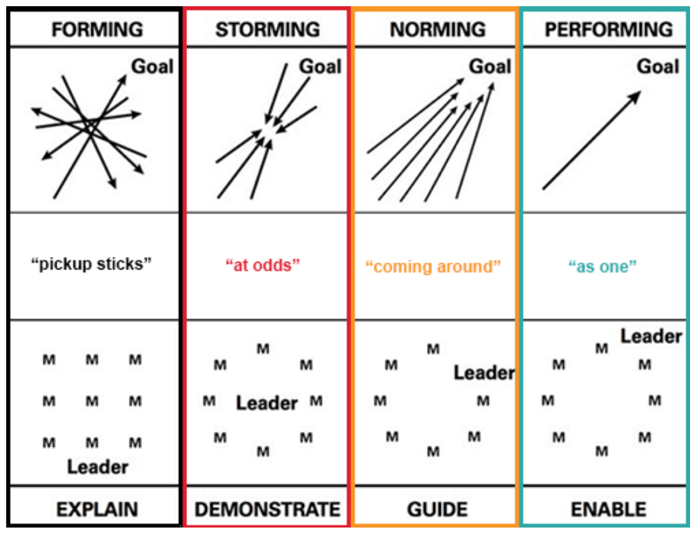As I journey through earning my Wood Badge -- the highest level of leadership training offered by the World Scouting Movement -- I realized that not only is this a phenomenal training for Scouters, but it’s a training anyone in the business world should take.
It teaches advanced leadership skills by having participants list out their personal goals and objectives on a “ticket.” Throughout the course, you must “work your ticket” through classroom time and application projects to hit your goals.
As a data analyst for a digital marketing and sales agency, everything I do is data-driven and goal-oriented. My job involves setting incremental goals to help lead our teams to achieve the big-picture goal for our clients. It’s a goal-driven approach to teamwork very similar to the basis of Wood Badge.
What is Wood Badge?
Think of Wood Badge as formalizing your goals and objectives.
For course participants, the goals are focused around our Scouting responsibilities but can easily be applied to our professional lives as well.
Goals and objectives are set on your “ticket.” The ticket term comes from military personnel back in the day of Lord Baden-Powell, founder of the Scouts. At that time, soldiers were expected to pay their own way back home at the end of their service. They would accomplish this by working for it, a process that was known as “working your ticket.”
The Wood Badge program gets its name from a necklace of wooden beads acquired by Baden-Powell during a military campaign in 1888 from the hut of African warrior chief Dinizulu. To this day, graduates of the Wood Badge program receive replica wooden beads to mark the occasion. The first gathering of Wood Badgers was held in 1919 in Gilwell Park outside of London, England, making 2019 the 100th anniversary of the course. To date, more than 100,000 Scouters worldwide have earned their beads.
Start by Creating Your Goals
In my professional role, I don’t use the ticket terminology, but I do create goals to help lead our marketing and sales teams to success. I start with the high-level, overarching goal of our clients and I work backward. I look to uncover what steps (or what short-term goals) it will take to get them home (the big picture goal).
You’ve likely heard of SMART goals, and these are woven into the Wood Badge experience to ensure your goals are achievable and have meaning (you don’t want to set goals just for the sake of setting goals).
SMART Goals
Specific - Describe your goal in detail. How is it important and what impact will it have on what you are trying to achieve?
Measurable - Describe how this goal will be measured. How will you know when you have accomplished the goal?
Attainable - Describe how this goal is attainable. Is the goal something that can actually be accomplished?
Relevant - Describe how the goal is relevant. How does this goal relate to your overall vision and what you are trying to achieve?
Timely - Describe when you are aiming to reach the goal by. Can the goal be reached in a reasonable amount of time?
Next, Build and Lead Your Team
There are various stages of development that any team goes through when they are first being brought together to work toward a common goal. The Wood Badge course teaches Tuckman’s stages of group development: Forming, Storming, Norming and Performing.
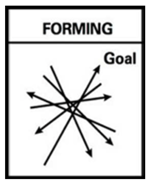 Forming: People are coming together for the first time and getting introduced to the goal of the team. This stage may involve existing teams when new projects are being introduced or teams where new people join or leave.
Forming: People are coming together for the first time and getting introduced to the goal of the team. This stage may involve existing teams when new projects are being introduced or teams where new people join or leave.
There is often excitement, anticipation and high expectations amongst the team as they are uncovering what needs to be accomplished. The leader of the team should provide lots of direction but little support as the team forms and comes together.
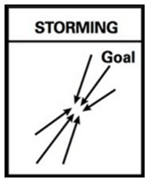 Storming: Team members are beginning to discover each other’s strengths and weaknesses. You can expect increased competition amongst the members, which may lead to some defensiveness and argumentation. Morale will start to decrease.
Storming: Team members are beginning to discover each other’s strengths and weaknesses. You can expect increased competition amongst the members, which may lead to some defensiveness and argumentation. Morale will start to decrease.
As a leader, it’s important to provide lots of direction and support to get the team back on track.
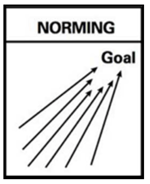 Norming: The team will start to come together and work with a sense of team cohesion and develop more of a ‘we’ mentality rather than ‘I.’ In order to reach this stage, team members will need to learn to accept constructive criticism and strive to achieve harmony.
Norming: The team will start to come together and work with a sense of team cohesion and develop more of a ‘we’ mentality rather than ‘I.’ In order to reach this stage, team members will need to learn to accept constructive criticism and strive to achieve harmony.
As a leader, begin to step back from a central role and provide decreasing direction and decreasing support as the team starts to gel.
 Performing: The ultimate goal is for your team to reach the performing stage, at which time there will be high morale and productivity. The members on the team will fully understand each other’s strengths and weaknesses and will be committed to continual improvement.
Performing: The ultimate goal is for your team to reach the performing stage, at which time there will be high morale and productivity. The members on the team will fully understand each other’s strengths and weaknesses and will be committed to continual improvement.
As the team becomes more self-sufficient, the leader will provide little direction and little support.
Evaluate Your Team During Each Stage
It’s important to evaluate your team for efficiency. As your team goes through the Forming, Storming, Norming and Performing stages, use the Wood Badge SSC evaluation method, also known as Start, Stop, Continue.
For example, in the digital marketing and sales industry, it’s imperative we, as an agency, keep up with industry trends and new ideas so we know what we should Start doing. We also must continuously evaluate results -- both good and bad -- so we know what we should Stop doing and what we should Continue doing. (In the digital marketing world, we call this CRO or Conversion Rate Optimization.)
Leverage Diversity in Your Team
Another key component to leading a successful team is leveraging diversity through inclusiveness. The more diverse your team, the more unique and fresh the ideas generated will be.
There are three main categories of diversity to consider when building a team:
- Human Diversity (gender, age, race, physical appearance, etc.)
- Cultural Diversity (lifestyle, heritage, beliefs, traditions, etc.)
- Organizational Diversity (roles, relationships, education, affiliations, etc.)
It can be difficult to build a highly-diverse team within a business organization, which is why businesses often use outside agencies and vendors or form partnerships.
Set Your Team Up for Success with an EDGE
One of my favorite sessions during Wood Badge was taking the EDGE™ training method and applying it to the various stages of team development.
A team’s ability to succeed depends on learning new skills, and as the need for these new skills arise, it is the leader’s responsibility to provide the needed training by either serving as the instructor or arranging for the instruction to occur.
For example, in the forming stage, the leader will need to explain the new skill and demonstrate the skill to get the team headed in the same direction. In the norming stage, the leader will guide the team in learning the skill. By the time the team reaches the performing stage, the leader should be able to enable them to take the new skill and apply it toward reaching the goal.
The EDGE™ Training Method
Explain – Talk about what you are training on and why it is important. Show the tools and resources you will be using. Incorporate charts and graphs if they apply.
Demonstrate – Show them what you want them to learn. Talk about what you are doing as you do it so they better understand your actions.
Guide – Give them the tools and let them try. Continue to talk them through it, and even demonstrate again if necessary. Patience is key in this step; the more they do it the better they will become.
Enable – Once they have mastered the new skill, the trainee will be able to demonstrate it to the trainer and others without needing guidance.
“Tell me and I forget, teach me and I may remember, involve me and I learn.” ~Benjamin Franklin
To Move Forward, Change
If there is one thing leaders all know, it is that change is inevitable. So how do you get your team on board for change?
The best thing you can do to lead your team through change is to empower others to help you. However, don’t just change for the sake of changing -- have a compelling reason to change and establish urgency.
Through the change process, you may have to leave some people behind if they refuse to change. But over time, your diligence will create a culture that embraces change and your team will become more comfortable with change through lifelong learning. This includes openness to new ideas, humble self-reflection and careful listening, in addition to taking courses and reading books.
“We cannot become what we need to be by remaining what we are.” ~Max de Pree
Continuing Your Leadership Journey
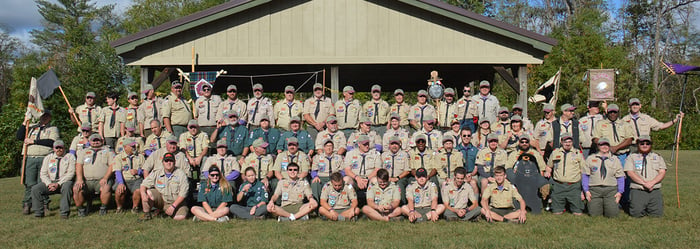
I would recommend the Wood Badge course to anyone in business seeking to advance his or her leadership skills. It uses hands-on activities to teach a wealth of principals, from communication, project planning and generational differences to problem solving, managing conflict, mentoring, self-assessment and leaving a legacy.
If the Wood Badge is not right for you, find another training opportunity. When it comes to leadership, the most important thing is to get started. Now, I’m off to “work my ticket.”

